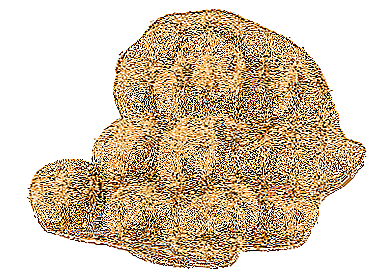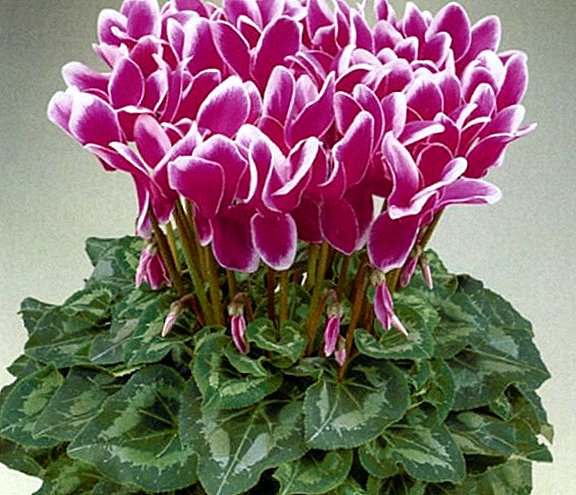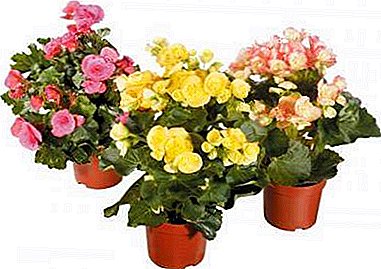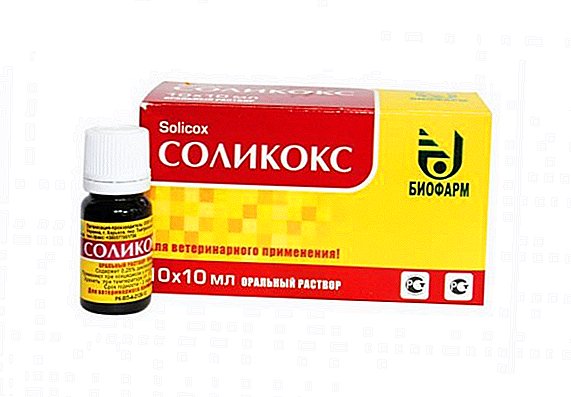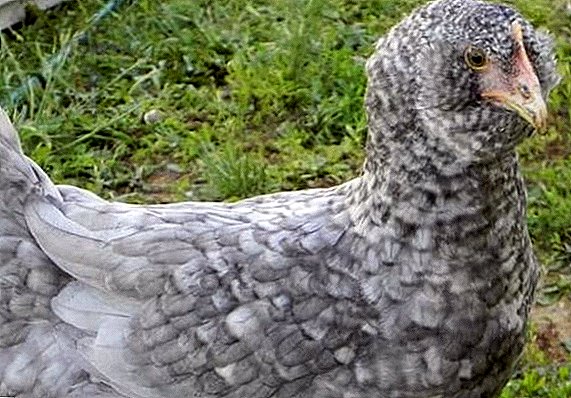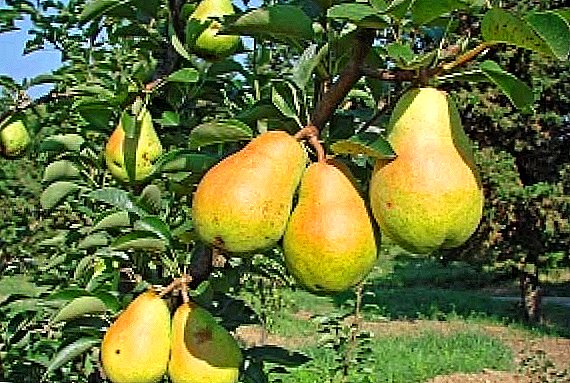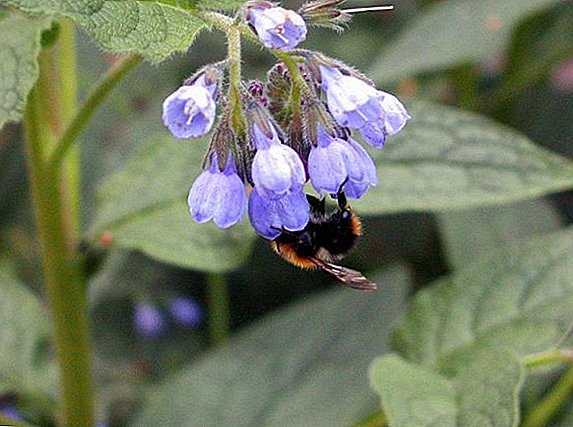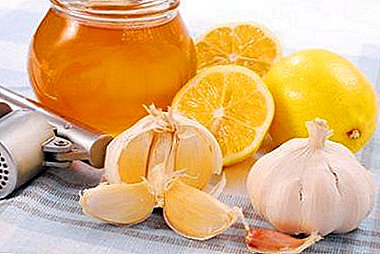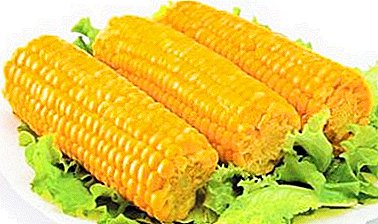 Nepentes (another name - the pitcher) is a member of the Nepente family, which has about 120 species of plants.
Nepentes (another name - the pitcher) is a member of the Nepente family, which has about 120 species of plants.
This "predator" mainly grows in the tropics, on the islands.
In this article, we will look at the rules for the care of the nepents flower;
a brief description of
Nepentes is shrub or semi-shrub vines. This plant has leaves two kinds of leaves: the first - large and oblong, and the second - pitcher-shaped. With the help of the second species, the flower produces its food. The jug is a rolled-up sheet of a special construction, resembling a container, in the form of which it received its name.  The jug is attached with antennae to ordinary leaves. Its colors are different, depending on the type of plant. These are mainly bright colors: red, crimson, pink, with spotty patterns or purple spots. The insect trap reaches a length of 2.5 to 30 cm.
The jug is attached with antennae to ordinary leaves. Its colors are different, depending on the type of plant. These are mainly bright colors: red, crimson, pink, with spotty patterns or purple spots. The insect trap reaches a length of 2.5 to 30 cm.
Its top edge is bent inward. On the edge of the jug, thanks to its special cells, sweet nectar is produced. Its interior is filled with digestive fluid or water. The neck is covered with a lid that protects the trap from debris.
Did you know? Basically, the plant feeds on insects, but it happens that small birds and toads get into the jars.
How to grow at home
Nepentes is a predator plant, and its habitat conditions are significantly different from domestic ones, so its growing at home has certain difficulties.
Location and lighting
This plant prefers a bright light, but diffused. The best place for him will be south or east window sills. If the pitcher grows on the northern or western windows, then it needs additional lighting. The backlight should work at least 16 hours. 
Temperature
Mountain species of nepentes develop well in summer at a temperature of about 20 ° C, and in winter at 15 ° C. Plain species prefer temperatures in summer from 22 ° to 26 ° C, and in winter from 16 ° to 20 ° C.
Important! If the temperatures are much lower, then there is a threat to the life of the plant.
The soil
For nepentes, you can choose a ready-made soil for orchids. But it is better to make an earthen mixture yourself. Required use such components (in a ratio of 3: 2: 1) - leafy ground, peat, large sand. In this composition, add moss and charcoal. Sometimes, peat (2 parts), perlite (2 parts), vermiculite (1 part) are used for the substrate.
Predatory (carnivorous) plants in nature, there are about 630 species from 19 families. Vivid examples of such plants are the sundew and the Venus flytrap from the Rosyanka family, fatfish (Bladderwort), sarracenia (Sarrasenie).
Watering
Nepentes loves wet substratebut does not tolerate waterlogging. Water the plant must be distilled water, settled or rain. Her temperature should be at room temperature or a couple of degrees higher. It is necessary to water a flower in the lower way, after which the excess water must necessarily drain. In the summer, they wet the nepentes every 2 days, and at a temperature below 16 ° C, watering is reduced to 1 time per week. 
Air humidity
"Predator" grows well in the room in which the humidity of the air in the range of 70-90%. But mostly 40-50% is enough for a pitcher. It is worth watching the plant - perhaps it can adapt to the usual humidity in the room. If this does not happen, it is necessary to spray the flower every day with separated water. You can also put the pot on a tray with wet clay or peat.
Is it necessary to additionally feed
It is not necessary to feed the soil. But if in the summer once a month to make a complex flower fertilizer, the consistency of which will be 3 times weaker than recommended, then it will not bring harm to nepentes.
Important! If you overfeed the "predator" with fertilizers, it will not form jugs.
When caring for nepenthes at home, do not forget to feed the flower once a month by throwing a fly, spider or bloodworm into the jar. It is not recommended to feed all the jugs, otherwise the plant will die from an excess of nitrogen. Bring insects only half of the jug-shaped leaves. You can also feed the flower with meat and curd.
Support
This exotic plant is a liana, so it stands for prepare a prop. It is necessary to tie nepents to the support when it reaches half a meter in height. It is recommended to install a support when you transplant a one-year-old flower. 
Pruning
Pruning nepentes is best in the spring when the growing season begins. Only adult plants need this procedure. Pruning is to remove old shoots. Due to this, the plant not only rejuvenates and becomes compact, but also begins to grow and branch more quickly.
Surprisingly, far-away biological relatives of nepentes are buckwheat, beet, rhubarb, spinach, sorrel, amaranth, celosia, cloves, quinoa, lithops. All of these plants are in the order of Clove flowers.
Do I need special care in winter
Consider how to care for nepentes in the winter. At this time, the plant begins a period of forced rest. This is due to the fact that our winters are different from tropical, the humidity of the air and the temperature is greatly reduced. It is not recommended to feed the plant during the winter period, as it does not have enough strength to digest food. Also, the intervals between watering should be increased.
In winter, the flower often begin dry jugs. Panicking about this is not worth it, because this plant is characterized by wilting of old leaves and the emergence of new ones. With the onset of spring, it is necessary to resume normal watering and apply a solution of fertilizers, and then the nepentes will again grow. 
How often do I need to transplant
The transplant is made if necessary: if the pot does not match the size of the roots, or a mold has appeared on the substrate. Transplant nepentes in the spring. If the flower is healthy, then it is simply rolled into a larger pot, trying not to damage the root system.
If you are concerned about the appearance of the flower, it must be removed from the old dishes, clean the roots of the substrate and rinse with distillate. After that, you should finish the transplant in the usual way.
Next, you need to spray and water the substrate with Topaz or Fundazole. In a couple of weeks, after successful rooting of the pitcher, it is worth sprinkling it with a solution of "Zircon" and pouring the substrate over it. If the transplant is done correctly, the nepentes will live in a new pot for 3-5 years.
Did you know? The name "Nepentes" appeared from ancient Greek mythology. Nepenfa was the name for the grass of oblivion.
Diseases and pests
Brown or red spots can sometimes appear on the leaves of an exotic plant - this is a sign of a fungal disease that develops due to increased humidity. To cure nepenthes, it is necessary to treat it with fungicides.  Due to overmoistening, the roots of the plant may also rot, the leaves may wrinkle, and the stem may turn black. The flower can be saved by removing it from the substrate and cutting off rotten areas and organs. Sections should be processed with crushed coal and plant nepentes in a sterile substrate.
Due to overmoistening, the roots of the plant may also rot, the leaves may wrinkle, and the stem may turn black. The flower can be saved by removing it from the substrate and cutting off rotten areas and organs. Sections should be processed with crushed coal and plant nepentes in a sterile substrate.
Yellow leaves indicate a lack of nutrition, and red are the result of sunburn. If a flower receives too much light, then brown spots appear on it, and due to lack of light, nepentes are drawn out and its development slows down. To cope with this will only correct care for the "predator."
Mealybug is one of the pests of nepentes. When it appears, it is necessary to moisten a cotton swab in a soapy solution, alcohol or beer and mechanically remove pests with it. Then the plant should be treated for six weeks with an interval of 7-10 days with a preparation based on imidacloprid.  Aphid is a carrier of viral and bacterial diseases. For nepentes this pest is very dangerous. To get rid of it, you need to dissolve 20 g of grated green potash soap in 1 liter of water and process the flower with this solution. At the same time soapy water should not get into the substrate. You can use dishwashing detergent or laundry soap instead of green potash. Also from aphids will help rid these drugs: "Karate", "Antitlin", "Detsis" or "Biotlin".
Aphid is a carrier of viral and bacterial diseases. For nepentes this pest is very dangerous. To get rid of it, you need to dissolve 20 g of grated green potash soap in 1 liter of water and process the flower with this solution. At the same time soapy water should not get into the substrate. You can use dishwashing detergent or laundry soap instead of green potash. Also from aphids will help rid these drugs: "Karate", "Antitlin", "Detsis" or "Biotlin".
Vegetative breeding methods
In nepentes reproduction occurs by seed, cuttings and division of the bush. Let's talk about vegetative methods.
Cuttings
The ideal cutting is a cut with 3 leaves, which are cut to 2/3. At the apical cuttings can not trim the top leaf. Before planting the plants, they must be placed in the “Kornevina” solution for 30 minutes and then powdered with crushed coal.
Pot for planting should be well washed with bleach, then it must be rinsed with distillate. The substrate should consist of sphagnum, coconut fiber, peat (2: 3: 5). It is necessary to add a little vermiculite and process the soil in the microwave for 15 minutes. The cuttings are immersed in the ground at 5 mm and gently press the ground around them. Substrate must be watered with distilled water, and the cuttings themselves sprayed "Fundazol." After that, the pot is covered with a plastic bag or a transparent plastic cap. The plant should be in a bright place where the temperature is 23 ° C. After 14 days, spray the cuttings and moisten the substrate with a solution of "Zircon".
Mostly rooted cuttings about a month or one and a half. But after 2 weeks it will be clear if they started: if new shoots with jugs have appeared, then the petioles have taken root, and if they have darkened - the landing has failed.
Dividing bush
By dividing the bush, the nepentes are propagated during plant transplantation. The roots of this "predator" are very fragile, so you need to very carefully carry out such a procedure. Propagating the flower in this way, it is necessary to lower the earthen ball into the water tank at room temperature before dividing - this will help to gently clean the roots of the substrate and avoid damage.
Nepentes is a plant that will decorate your home and bring in a bit of exotic. Therefore, you can put up with the difficult care of the "predator" and settle such a flower in your apartment.


